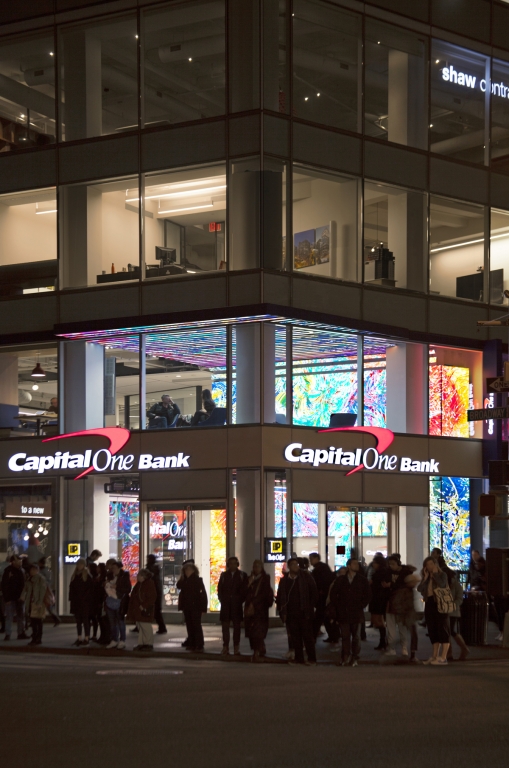Capital One is a diversified bank that offers financial services to small businesses, consumers and commercial clients. The bank recently opened its Manhattan flagship location in Union Square with a delightful LED wall to both unify its interior banking space and act as a destination beacon to attract and engage pedestrians in visiting that branch.
Combining both form and function into a singular presence, Gilmore Group (New York City), an interdisciplinary design, branding and marketing company, enlivened the bank with unique LEDs that draw curious pedestrians and strengthen branding. The scope of the design includes an illuminated brand wall that wraps around ground-floor ATMs, then travels upward to the bank’s mezzanine level, covering this second floor wall before surging upward to stretch across the ceiling. From the ceiling, the LED panels extend out of the building and become an exterior sunshade over its entrance by day and an illuminated beacon by night. Gilmore Group conceptualized the interior, while CallisonRTKL (New York City) served as the architect of record.
USE IT FOR EVERY PURPOSE
Louis Lombardi, Gilmore Group’s managing partner, noted, “Our design strategy was to use light, color and motion to create a brand beacon that would draw attention to the bank. We knew LEDs would be the way to go, but rather than use the LEDs as signage to create a message center look, we decided to create a big environmental art piece that would visually engage bank customers. Not only did the LED wall create a focal point within the bank, but the bank’s floor-to-ceiling glass windows also provided a very visible street presence.”
In establishing the LED design for the Capital One Union Square branch, several banking operation and design considerations were taken into account. Placement of the LED wall behind the ATMs was critical because the machines are one of the first things customers see upon approaching a bank, and the LED wall is now a great differentiator for the branch. With its varied colors, interior LED lighting acts as a brand signature, creating a dynamic background for on-site customers. “One concern we had with the LEDs was that their lighting could become overbearing and somewhat garish as different colors might change skin tones and create unflattering looks to people under that lighting,” said Lombardi. “That concern was unwarranted; once installed and tested with people in the room, it became a negligible effect and [was] not unpleasant at all.”
UNLIMITED LEDS
The LED wall and ceiling were created by D3 LED (New York City) with a variety of their LED products including a 2.6mm surface-mounted device (SMD) module used for the ATM wall display and the mezzanine wall. To enhance the mezzanine’s visual presence, its ceiling was transformed into continuing rows of LED slats that incorporated a 4mm SMD. The exterior sunshade/canopy was designed with a 16mm pitch.
American Signcrafters Inc. (Islip, NY) installed Capital One’s LED displays, and also designed and fabricated the custom ATM wall vestibule, including its two fully customized LED wall displays, the second floor LED mezzanine wall, the LED ceiling and the custom fabricated protruding sun shade.
Advertisement
“We began by building a base structure for the ATM LED displays, which was an aluminum subframe that allowed us to mount all the LED modules (NTECH-NT 2.6mm SMD) on an even horizontal plane,” said Tom Garatina, business development manager. “The D3 LED modules were attached to the subframe on a plug-and-play basis in which each succeeding LED panel was interconnected to each other with data and power from panel to panel. Once assembled, the ATM walls were covered with a series of Polycast SAR [super abrasion resistant] Acrylic Sheets to protect its LED surface in high-contact areas.”
WHAT’S IN YOUR LOBBY?
On the second floor mezzanine, American Signcrafters mounted the NT 2.6 SMD LED panels directly to the mezzanine wall and connected to the subframe in a similar way to the ATM wall assembly. As the LED wall curved towards the ceiling, its display was separated into a series of horizontal (NCORE-NC4-SMD) LED strips mounted across the ceiling, according to Garatina. Initially, horizontal raceways were anchored into the ceiling with Unistruts and threaded rods, with the LED modules then attached to the raceways.
The team also extended LEDs beyond the building façade to create the exterior illuminated canopy. “One of the challenges of the project was that both the developer and the landlord’s architect had felt the building didn’t need an exterior canopy,” said Lombardi. “We countered that the placement of the illuminated canopy would be a benefit to the bank’s success, draw more eyes onto the building and increase the brand value of the property. Inevitably, the landlord agreed and the final design was accepted.” And the ultimate test? Lombardi knew the design worked when his 10-year-old son remarked “how cool it looked.”
Louis M. Brill is a journalist and consultant for high-tech entertainment and media communications. He can be reached at louismbrill@gmail.com.



 Tip Sheet2 weeks ago
Tip Sheet2 weeks ago
 Photo Gallery3 days ago
Photo Gallery3 days ago
 Ask Signs of the Times5 days ago
Ask Signs of the Times5 days ago
 Real Deal2 weeks ago
Real Deal2 weeks ago
 Paula Fargo21 hours ago
Paula Fargo21 hours ago
 Benchmarks1 week ago
Benchmarks1 week ago
 Photo Gallery21 hours ago
Photo Gallery21 hours ago
 Women in Signs2 weeks ago
Women in Signs2 weeks ago







